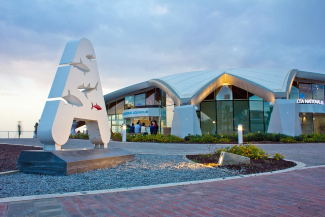Project History
The concept for a national aquarium has been on the cards for many years. Two factors contributed to the lengthy time taken for the project to take off: the selection of an appropriate site and the identification of a sustainable operating model that would achieve the project objectives without depending on government financial subsidies.
The first attempt to build a public aquarium commenced in 1993, when the Ministry of Tourism had identified the site at Qawra Point as a possible location for this project, noting that the area constituted a tourism zone in decline which required investment in general. Despite the process for this project started in 1993, culminating in an International Call for Offers in 1996, the process was discontinued following the realisation that the project was not feasible if it were to be funded solely from private sources.
Government considered the option of constructing and operating the aquarium through a public entity. This option was likewise considered as not sustainable. Eventually it was decided to opt for a Public Private Partnership. The Malta Tourism Authority was entrusted to carry forward this project on behalf of the Government of Malta. The MTA developed the project concept, applied and obtained the ERDF funding for the project, managed, in conjunction with the Department of Contracts, the tendering process which led to the selection of the private partner.

Project Description
The total cost of the entire project is of €15.6 million of which €8.85 million are being funded through the European Regional Development Fund with the rest of the funds coming from the private investors (Marine Aquatic Ltd).
The project is spread over approximately 20,000 square meters and comprises of a public aquarium, a public garden at promenade level, a multi storey car park, facilities for local dive schools, catering facilities including a reef club, a merchandise outlet and a tourist information kiosk.
The entrance to the Malta National Aquarium is characterised by a timber dome roof, spanning approximately 52 metres in total and supported solely on concrete plinths at the perimeter. The principal structure of the dome is made from curved laminated timber beams, joined together by steel nodes while the secondary structure is made up of smaller glulam-beams, which supports the overall cover to the structure. All the beams of this dome have been constructed from wood originating from sustainable forests within Europe. This shell structure in the form of a starfish is providing an attractive architectural landmark in the landscape and promenade of Qawra.
The national aquarium itself is housed in an underground building located under the promenade level. The aquarium, which houses 26 tanks, 3 of which are freshwater tanks, houses over over a 100 different species, mostly of which Mediterranean fish found around the Maltese coast. One could also find tropical marine fish from oceans and seas around the world, including sharks and rays. Every aquarium has its own life support system to avoid the spread of any possible disease or infection.
The main tank of the aquarium contains species from the Indian Ocean, including sharks and rays. The main tank is approximately 12 meters in diameter. Visitors are able to go through a water tunnel thereby experiencing the fish at a much closer distance.
All tanks where expertly themed to replicate the underwater environment and has taken cues from the Maltese coast and heritage. An emphasis has been placed on the diving wrecks present around the Maltese Islands in order to promote awareness of this important tourism niche.
Additional features of the public aquarium include a class room area, interpretation, touch pools, a temporary exhibition space, veterinary and quarantine facilities
The garden and Piazza San Pawl provide additional recreation facilities for pedestrians who frequent the popular Qawra promenade. The car park has a capacity of over 160 cars.
In line with the project objectives, the Malta National Aquarium will work closely with a number of local marine conservation groups with the aim to enhance awareness of the local marine flora and fauna. In fact, the Malta National Aquarium is also an educational facility where children and adults alike can learn about the biology of the species.
Diving Lectures at the Diving Institute, Malta National Aquarium
Over the past years, the Maltese Islands have been repeatedly voted amongst the best diving destination in the World. The water surrounding our Islands is endowed with an unparalleled beauty with a combination of marine life , caves, reefs and incredible submerged topographies. Furthermore, historic shipwrecks and crashed aircraft still lying on the seabed provide testimony to Malta’s rich history. Complimenting these are a series of wrecks that have been scuttled to act as artificial reefs which in turn provide some enticing dive sites.
In its role of a supporter and promoter of the operators from the diving industry, the Malta Tourism Authority together with the University of Malta and PDSA recently organised a lecture series aimed specifically at the Diving communities. Through this series the Malta Tourism authority disseminated knowledge about the underwater world.
Attendees were provided with first hand knowledge on safety at sea including life saving information on search & rescue. Due to the efforts of the organisers, several renowned professionals, shared their knowledge in a variety of subjects including underwater cultural heritage and archeology that one can find around the Maltese Islands, marine life and habitats, marine reserves and sustainable diving.
These lectures were held at the Diving Institute at the National Aquarium and were very well attended by several diving clubs as well by other interested individuals.
The second part of this ERDF project targeted the improvement of a derelict area in front of some of the main 5-star resorts in this area and its conversion into a public garden. Furthermore, the project involved the establishment of a park (Pembroke Heritage Project) across the former military shooting ranges - based on a walking/cycling trail that links the new garden with the Madliena Tower.